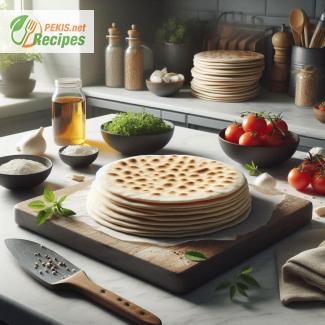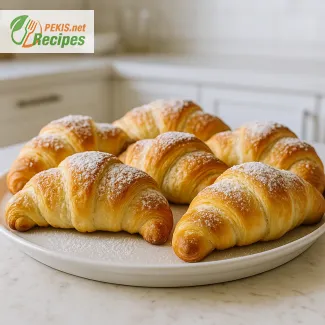
Few breads evoke the rich culinary heritage of the Mediterranean quite like pita bread. This versatile, flat bread, beloved for its soft texture and airy pocket, is a staple food across the Middle East, Greece, and beyond. Its simplicity, yet remarkable ability to pair with countless dishes, has cemented its place in kitchens around the world. From serving as a vessel for hearty fillings to scooping up creamy dips, pita bread is more than just food—it’s a culinary canvas.
The origins of pita bread stretch back thousands of years, rooted in the ancient ovens of the Middle East. This humble creation, made from a few basic ingredients—flour, water, yeast, and salt—has traveled through time and across borders, becoming a global favorite. Its characteristic pocket, which forms during baking, is both a scientific marvel and a practical boon, allowing it to be easily stuffed with ingredients or split into smaller portions.
What makes pita bread truly exceptional is its versatility. While many breads serve as mere accompaniments, pita bread plays an active role in the meal. Its pillowy softness and slightly chewy texture make it perfect for holding juicy kebabs, fresh vegetables, or savory shawarma. When paired with classic dips like hummus or tzatziki, it transforms into an edible scoop, elevating the dining experience. The toasty, slightly nutty flavor of pita, whether served warm or cold, complements a wide variety of tastes and textures, making it indispensable in Mediterranean cuisine.
For health-conscious diners, pita bread offers an additional bonus: it’s a low-fat, nutrient-rich option, especially when made with whole-grain flour. Packed with fiber, protein, and essential vitamins, it’s a wholesome choice that satisfies without excess calories. Unlike heavier breads, pita’s lighter composition aligns beautifully with the fresh, balanced flavors typical of the Mediterranean diet, which is renowned for its health benefits.
In Greece, pita bread is synonymous with gyros—a popular street food featuring flavorful meat, tangy sauces, and fresh vegetables, all lovingly wrapped in warm, soft pita. On the shores of Lebanon, pita is paired with tabbouleh or baba ghanoush, allowing these vibrant dishes to shine. In Israel, it’s an essential component of falafel wraps, delivering a satisfying crunch with every bite. Each culture has adopted pita bread in unique ways, making it a culinary chameleon adaptable to a spectrum of flavors and traditions.
But pita bread isn’t just a vehicle for savory delights; it can also take a sweet turn. Drizzled with honey, sprinkled with cinnamon sugar, or layered with nut butters, pita can quickly transition from savory to indulgent, offering endless opportunities for creative meals or snacks.
For home cooks, pita bread is a joy to make. The process of kneading the dough, watching it puff in the oven, and enjoying its freshly baked aroma is deeply satisfying. It’s a reminder of the simple pleasures of baking, where a handful of basic ingredients can yield something extraordinary. Whether baked in a traditional clay oven or a modern kitchen, the result is always comforting and delicious.
In modern times, pita bread has transcended its regional roots to become a global favorite, featured on menus in both high-end restaurants and casual eateries. Its popularity speaks to its universal appeal—it’s the perfect blend of simplicity and sophistication, suitable for quick snacks or elaborate meals. Whether you’re crafting a classic Greek souvlaki, assembling a vegan falafel wrap, or simply enjoying a warm piece with olive oil and za’atar, pita bread remains an irreplaceable part of the Mediterranean table.
For those who cherish authentic, versatile, and healthful food, pita bread is a must-try. It’s a timeless reminder of the culinary genius that emerges when cultures celebrate the beauty of simplicity. Whether you’re enjoying it fresh from the oven or picking up a pack from your local bakery, pita bread connects us to a rich tapestry of history, culture, and flavor—a true cornerstone of Mediterranean cuisine.
1. Activate the Yeast (10 minutes)
- In a bowl, mix warm water, yeast, and sugar. Let it rest for about 10 minutes until frothy.
2. Prepare the Dough (10 minutes)
- Combine the flour and salt in a large bowl.
- Gradually add the yeast mixture and olive oil. Mix with a wooden spoon or hands until a dough forms.
3. Knead the Dough (10 minutes)
- Knead the dough on a lightly floured surface for 8–10 minutes until smooth and elastic.
4. First Rise (1 hour)
- Place the dough in an oiled bowl, cover with a damp cloth, and let it rise in a warm place until doubled in size (approx. 1 hour).
5. Shape the Pitas (10 minutes)
- Punch down the dough and divide it into 8 equal portions. Roll each into a ball, then flatten into a disc about 20 cm (8 inches) in diameter and 6 mm (¼ inch) thick.
6. Cook the Pitas (30 minutes)
- Preheat the oven to 250°C (480°F). Place a baking stone or heavy tray inside.
- Bake each pita on the hot surface for 2–3 minutes until puffed and slightly golden.
7. Cool and Serve
- Let the pitas cool slightly. Serve warm or store in an airtight container.
Tips to Enhance and Adapt Your Pita Bread Recipe
Pita bread is a classic Mediterranean staple with a simple yet adaptable recipe. Whether you’re aiming for a more traditional flavor, specific dietary requirements, or creative twists, there are many ways to refine and personalize this recipe. Below are detailed tips to help you optimize the texture, flavor, and nutritional value of your pita bread.
1. Improving Dough Texture
The hallmark of great pita bread lies in its soft, pliable texture and the signature pocket. Achieving the perfect consistency requires attention to ingredients and techniques:
- Hydration Level:
The water-to-flour ratio is critical. If your dough feels too stiff, gradually add a teaspoon of water at a time during mixing. A slightly sticky dough ensures softer pitas. - Kneading Tips:
Knead the dough for at least 8–10 minutes to develop gluten, which is essential for elasticity and the formation of the pocket. If kneading by hand, fold and press the dough rhythmically. For efficiency, a stand mixer with a dough hook attachment works perfectly. - Resting and Rising:
Allowing the dough to rise in a warm, draft-free environment enhances gluten structure and texture. Covering the dough with a damp cloth prevents a dry surface. - Rolling Technique:
Roll each portion evenly, ensuring consistent thickness (about 6 mm / ¼ inch). Uneven dough can prevent puffing during baking. Use minimal flour while rolling to maintain hydration.
2. Enhancing Flavor
While pita bread is traditionally neutral in flavor, small tweaks can create exciting variations:
- Flour Blends:
Substitute 25–50% of all-purpose flour with whole wheat, spelt, or rye flour for a nutty flavor and added nutrition. Sifting whole-grain flour before use improves texture. - Flavor Additions:
- Herbs and Spices: Add 1 tsp of dried oregano, thyme, or za’atar to the dough for a Mediterranean flair.
- Garlic or Onion Powder: Mixing ½ tsp into the flour enhances savory undertones.
- Infused Oil: Use garlic- or rosemary-infused olive oil instead of regular olive oil for a subtle aroma.
- Sweet Variations:
Incorporate 1 tbsp of honey or molasses into the water mixture to create a slightly sweeter pita, ideal for pairing with nut spreads or breakfast options.
3. Adjusting for Dietary Preferences
For those with dietary restrictions or preferences, the recipe can be modified without compromising quality:
- Gluten-Free Pita:
Replace all-purpose flour with a gluten-free blend. Adding 1 tsp xanthan gum ensures elasticity and structure, while increasing the kneading time helps mimic gluten development. - Dairy-Free and Vegan-Friendly:
The original recipe is naturally dairy-free and vegan, but ensure that no dairy-based flours or sweeteners (like milk powder) are accidentally included. - Low-Sodium Option:
Reduce the salt by half for a low-sodium version. You can offset the flavor loss by sprinkling coarse salt on the pita before baking or serving. - Enriched Pita:
Add 1 tbsp of powdered milk or a beaten egg for extra richness and softness (note: this is not vegan-friendly).
4. Baking and Cooking Adjustments
The cooking method significantly impacts the final result. For a more traditional or personalized touch, try these tips:
- High-Temperature Baking:
Ensure the oven is preheated to the highest possible temperature (at least 250°C / 480°F). A hot oven creates the steam needed for the pocket to form. - Baking Surface:
Use a baking stone, cast iron skillet, or heavy baking tray preheated for at least 15 minutes. This helps replicate traditional clay ovens, ensuring even puffing. - Stovetop Method:
For a quick alternative, cook the rolled dough on a hot skillet or griddle. Flip when bubbles appear, and press gently with a spatula to encourage puffing. - Freezing for Convenience:
Partially cook the pitas (until puffed but not browned) and freeze them. When needed, reheat in a hot oven or skillet for freshly baked flavor.
5. Nutritional Enhancements
For health-conscious diners, these modifications boost nutritional value:
- Whole-Grain Pita:
Using whole wheat flour increases fiber content, supporting digestion and prolonged satiety. - Added Seeds:
Incorporate 1 tbsp of chia seeds, flaxseeds, or sesame seeds into the dough for added omega-3 fatty acids, calcium, and a slight crunch. - Fortified Flours:
Opt for flours fortified with iron or B-vitamins to increase the nutritional profile, especially beneficial for vegetarians.
6. Creative Serving Ideas
To elevate your pita bread as part of a meal, consider these serving suggestions:
- Stuffed Pitas:
Fill with falafel, fresh vegetables, and tahini for a classic Middle Eastern wrap. - Pizza Base:
Use pita as a quick pizza crust. Spread tomato sauce, cheese, and toppings, then bake until golden. - Chips and Dips:
Cut pita into triangles, brush with olive oil, sprinkle with za’atar or paprika, and bake until crispy. Serve with hummus or guacamole. - Dessert Pita:
Brush with melted butter, sprinkle with sugar and cinnamon, and bake for a sweet treat.
7. Troubleshooting Common Issues
If your pita bread doesn’t turn out as expected, these fixes may help:
- No Pocket Formation:
- Ensure the oven and baking surface are hot enough.
- Roll the dough evenly and not too thin.
- Avoid over-proofing, which can weaken the structure.
- Dry Pitas:
- Check the hydration level of the dough.
- Cover the dough balls and baked pitas with a damp cloth to retain moisture.
- Tough Texture:
- Avoid over-kneading, which can make the dough overly elastic.
- Ensure proper resting time to allow gluten to relax.
8. Elevating Presentation
For serving pita bread in a visually appealing way, consider these tips:
- Brush warm pitas with olive oil and sprinkle sesame seeds or herbs for added charm.
- Stack pitas in a woven basket lined with a cloth napkin to retain warmth.
- Serve with small bowls of flavored oils, spices, or fresh toppings to encourage customization.
9. Storing Leftovers
Proper storage ensures your pita bread remains fresh:
- Short-Term Storage: Keep in a sealed bag or container at room temperature for up to 2 days.
- Long-Term Storage: Freeze in airtight bags for up to 3 months. To reheat, sprinkle with water and warm in the oven.
10. Experimentation and Personalization
Pita bread is a blank canvas for culinary exploration. Use this recipe as a foundation to create new flavors and combinations. From blending global spices into the dough to pairing with creative fillings, the possibilities are limitless.
With these enhancements and adaptations, your pita bread can transition from a simple flatbread into a centerpiece of any meal!
- Contains Gluten: This recipe uses all-purpose and whole wheat flour.
- Allergy Substitution Tips:
- Use gluten-free all-purpose flour and add 1 tsp xanthan gum for elasticity.
- Iron: 1.6 mg – supports red blood cell production.
- Vitamin B1 (Thiamine): 0.1 mg – aids in energy metabolism.
- Magnesium: 10 mg – essential for muscle and nerve function.
- Calcium: 10 mg – contributes to bone health.
- Vitamin E: 0.2 mg – protects cells from oxidative damage.
- Selenium: 4 mcg – boosts immune function and prevents cellular damage.





